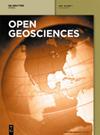IG-YOLOv5-based underwater biological recognition and detection for marine protection
IF 1.7
4区 地球科学
Q3 GEOSCIENCES, MULTIDISCIPLINARY
引用次数: 0
Abstract
Underwater biological detection is of great significance to marine protection. However, the traditional target detection techniques have some challenges, such as insufficient feature extraction for small targets and low feature utilization rate. To address these challenges, an underwater biological detection model IG-YOLOv5 based on the idea of feature reuse is proposed. An Improved-Ghost module with feature reuse is designed. The module adds batch normalization operations to the identity mapping branch using the Add operation with feature fusion and the Sigmoid Linear Unit activation function with smoother zeros. The proposed model uses the Improved-Ghost module to reconstruct the CSPDarknet structure of YOLOv5, so as to realize the lightweight and accuracy improvement of the model. In addition, in order to solve the problem of target size and shape change in underwater environment, the optimized loss function is Wise-IoU v3, which is used to evaluate the accuracy and robustness of detection results. The results show that the IG-YOLOv5 model performs well in the 2021URPPC data set, with 0.5 mAP reaching 74.2, 4.3% higher than that of YOLOv5 model, and 2.7 less floating-point operations. In a word, IG-YOLOv5 model has high accuracy and robustness in underwater target detection, and Wise-IoU index can evaluate the quality of target detection results more accurately, which is suitable for underwater robots, underwater monitoring, and other fields and has a practical application value.基于 IG-YOLOv5 的水下生物识别和探测技术,用于海洋保护
水下生物探测对海洋保护具有重要意义。然而,传统的目标检测技术存在一些挑战,如小目标特征提取不足、特征利用率低等。针对这些挑战,本文提出了基于特征重用思想的水下生物检测模型 IG-YOLOv5。设计了一个具有特征重用功能的改进型幽灵模块。该模块使用带有特征融合功能的添加操作和带有平滑零点的西格莫线性单元激活函数,在身份映射分支中添加了批量归一化操作。所提出的模型利用改进型幽灵模块重构了 YOLOv5 的 CSPDarknet 结构,从而实现了模型的轻量化和精度提升。此外,为了解决水下环境中目标大小和形状变化的问题,优化损失函数为 Wise-IoU v3,并以此来评估检测结果的准确性和鲁棒性。结果表明,IG-YOLOv5 模型在 2021URPPC 数据集中表现良好,0.5 mAP 达到 74.2,比 YOLOv5 模型高 4.3%,浮点运算减少 2.7 次。总之,IG-YOLOv5 模型在水下目标检测中具有较高的精度和鲁棒性,Wise-IoU 指标能更准确地评价目标检测结果的质量,适用于水下机器人、水下监测等领域,具有实际应用价值。
本文章由计算机程序翻译,如有差异,请以英文原文为准。
求助全文
约1分钟内获得全文
求助全文
来源期刊

Open Geosciences
GEOSCIENCES, MULTIDISCIPLINARY-
CiteScore
3.10
自引率
10.00%
发文量
63
审稿时长
15 weeks
期刊介绍:
Open Geosciences (formerly Central European Journal of Geosciences - CEJG) is an open access, peer-reviewed journal publishing original research results from all fields of Earth Sciences such as: Atmospheric Sciences, Geology, Geophysics, Geography, Oceanography and Hydrology, Glaciology, Speleology, Volcanology, Soil Science, Palaeoecology, Geotourism, Geoinformatics, Geostatistics.
 求助内容:
求助内容: 应助结果提醒方式:
应助结果提醒方式:


